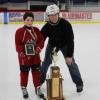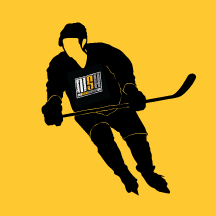Slate
Blackcurrant
Watermelon
Strawberry
Orange
Banana
Apple
Emerald
Chocolate
Marble
Slate
Blackcurrant
Watermelon
Strawberry
Orange
Banana
Apple
Emerald
Chocolate
Marble
-
Content Count
402 -
Joined
-
Last visited
-
Days Won
8 -
Feedback
0%
Content Type
Profiles
Forums
Downloads
Gallery
Store
MSH News and Articles
Everything posted by smcgreg
-
Less imitation? Hmm.... that back end looks a lot like another skate.... which one?? Hmmm....
-
As Vet88 writes above and I have commented on several times on this site, orthotics will only exacerbate pronation. My son has feet as flat as boards and orthotics made his pronation worse and killed his feet. For his flat feet, skates with no support feel best. He wears orthotics in his athletic shoes, which are necessary to avoid problems, but only make things worse in his skates. In my case, I pronate on my right foot, but am neutral on my left. In this case, it's not truly pronation, but the weight is inside the center of the foot and hence more on the inside edge, because with old age, my right knee has become Valgus. This was not an issue when I skated as a kid and young adult. It only became a problem when I started skating again in middle age. Anyway, the only thing that has worked for me is to have the blade moved inward to move it back under the center of pressure of my foot. This isn't sufficient alone, as I've also shimmed under the holder, but actually shimmed the outside of the skate rather than the inside (which is what one would do for pronation in shoes). Anyway, I would not look to orthotics to solve a situation where one "pronates" in skates. Again, this has been discussed extensively in various threads I've commented on.
-
I'm not in Trues, but when I went from Supremes to Makos I found a similar issue. I left the top two undone on my Supremes, but since the Makos were lower, I didn't feel like I could do that, so, I laced them all the way up and felt like I lost some forward flex. So, I went to 55 flex and that fixed the issue. Now, the problem is that 55 flex is no longer around (add it to the list of innovations that went away), so, I've had to get GREAT SAVES alternative. I actually don't like them as much as the 55 flex, but after some fiddling, got them to work like my old set up. So, my point is, if your other attempts don't work, you might want to try the lace extender to improve flex. Again, I felt exactly the same way when I initially moved to Makos.
-
As I said in the immediate previous reply to another poster, I had the same issue. I skate a lot and gave it 2 years. After 2 years, I gave up and got rid of the extreme pitch. Much better.
-
I skate 4-6 times per week and gave the aggressive pitch 2 years. I use a deep knee bend on a skate with neutral pitch. I don't need to skate in high heels to exhibit a deep knee bend .... when appropriate. That being said, I felt the exact same way, when not skating, but battling on the boards or in front of net, I continually fell forward. I was simply off balance. I also washed out a lot on turns. So, after 2 years, I had had enough. I had the pitch eliminated from the steel ( still have the holder pitch) and problem solved! In response to the poster wondering how to address the pitch, I've used both approaches. Both my son and daughter have Makos as well (I've stocked up 6 pairs for the kids to grow into). On my son's we put TUUK holders and LS runners. This would eliminate most of the pitch and matched his old Vapors pretty well. The problem is, the rivets pull out a lot. They don't align perfectly and are stressed too much. There have been a couple of times I've taken them in to get sharpened and loose rivets have been identified. In one case, we were in the middle of a tournament and they were so bad, J.R. had to redo one skate while I waited on a busy Saturday afternoon so, he could play 40 min later. (As always, great service J.R.) On my daughter's, we just went -3 on the pitch and that brings her close to her Jetspeeds, but still gives her probably a plus 1 pitch. They were +4 out of the box, which is crazy!
-

Sparx Skate Sharpener - At home sharpener
smcgreg replied to tamtamg's topic in Ice Hockey Equipment
Your post is the perfect sales pitch for this product. The point in your comment that I underlined and bolded is the exact point that many people out in the world feel is the compelling reason to get the product. If you have "that guy" around the corner that does things the way you want it consistently every time, then the product is redundant and a waste of money. OTOH, not many people have "that guy" and the exact statement that "Too many unknown variables from one shop to the next at play here" is exactly what sells the product to many. -
Agreed. Even the most innocuous pass can really sting if you get it on Makos. I'm a beer leaguer, so, don't worry about blocking shots anymore, but my son plays D and I've told him he should wear shot blockers for his. He doesn't want to, but I'm pretty sure he'll change his tune the first time he takes a shot.
-
As Althomas, I have stocked up. I've got a pair of Mako IIs and M8s for myself, I figure that will cover me for about 5 years and it was less than $500 for both. My son started in MIIs this summer and loves them, so, I just got him a pair for when he grows out of these . I figure between his current and this new pair, I should be covered for 2 years. We'll see what's available at that point. Hard to pass up these deals though. As he said, even if there is a comparable skate in the future, there's no way it will be even close to this cheap and may not even be as good.
-

Sparx Skate Sharpener - At home sharpener
smcgreg replied to tamtamg's topic in Ice Hockey Equipment
In fact, some may even give you a 1/2 in unbeknownst to you, because they think they know better. It's happened to me before. As if I wouldn't be able to tell. When approached, they told me they wanted to prove to me that it wouldn't make any difference. Needless to say, I don't go there anymore. -

Sparx Skate Sharpener - At home sharpener
smcgreg replied to tamtamg's topic in Ice Hockey Equipment
Glad he was able to land on his feet. I hear you'll have to deal with Darren though... ;-) My son Liam was asking what was going to happen to Darren and Jose today. I told him Darren would be at Troy and Jose would be at Novi. He said, "Darn it. That would have been great if JR, Jose and Darren were all at the same store". That's the kind of impression the TH people from around here have made on him. How many 11 yr olds look forward to seeing the staff at their LHSs? On the TH front, I think they made a mistake closing AA. People were just starting to realize it was there. Seriously, last winter, people who frequented the Cube still didn't even know it was there. I think one more year and it would have been as profitable as Novi or better. Lots of underserved population in and west of Ann Arbor with nowhere else to go now. Not to mention tournaments, etc. but.. I digress. Back to the topic at hand... Novi still isn't all that close. With 3 people in the family all skating 4 or more times per week (actually my daughter's in figure skating too, so, add another pair of skates), without having a reliable shop in the neighborhood, it's really not practical to have to go out of town for a sharpening. I'll give it some time to see how the logistics can work out before pulling the trigger though. I'll probably try running up to Novi a couple times or having Darren take care of my steel at Troy since he'll be on the ice with me a couple times/week. Still, not as handy as what I've had the past two years. I'm pretty spoiled right now. -

Sparx Skate Sharpener - At home sharpener
smcgreg replied to tamtamg's topic in Ice Hockey Equipment
Given that it appears my local TH will be closing, I guess I'll be getting one of these. I don't trust the sharpenings anywhere else that's close to me and I'm not driving an hour to JR's shop. So, since this machine seems to be pretty consistent, it should pay for itself within about a year, if not, two. Plus the convenience of having it done when I want, the way I want. -
Well, I've tried everything. .... literally. My Mako IIs are Frakenskates right now and fantastic for my feet. It took me a while to get mine dialed in and I've had Makos or Mako IIs since two weeks after they came out ... what, 3 or 4 yrs ago. My point was simply that I can see pretty much anyone (narrow or wide heel) having heel lock issues since the heels open up so much with baking. As you should probably know, unlike other skates, these are not really foot type specific. That means, whatever the type of foot, they can fit you, but at the same time, whatever the type of foot, you can have issues as well. I'll be buying two pairs (M8 and MII) to carry my through the next 5 years as Easton disappears and cross my fingers that Bauer will incorporate the technology, at least moldability, if nothing else. Ironically, probably the greatest innovation MLX had, the adjustable holders, didn't even carry over to the Makos, so, I'm not holding my breath. **edit: the other point I was making was, although I don't have heel lock issues when I step on the ice, after skating a while (especially now with this heat and humidity) I do have them since the skates get so damn wet and my heels slip a bit. Still, all in all, a nit picky problem.
-
Lucky you ;-)
-
Actually, the heel can be pretty wide as it opens up with baking. I have a fairly wide heel (wide foot overall) and I have issues with heel lock as well. It's particularly bad this time of year with the heat since they get so darn wet and my feet start sloshing around after 30-45 min. Still, best skate there is. Anyway, my point was, I have a wide heel and the Mako II can be a bit sloppy for me as well.
-
I have several posts on this topic (i.e. superfeet and flat feet) in various threads. I think the general argument that Superfeet are good for pronation and/or flat feet is misguided. I have pronation issues myself, but more to your point, my son has VERY flat feet, with hyperlaxity (i.e. flexible arch). Over the years, I tried many different insoles, including superfeet, and they all made him miserable. For the past 3 years, he has been in Vapors (that fit his foot shape and volume), with the stock minimal footbed and no complaints. This past week, we just got him a pair of Makos and slapped on TUUK holders and use the stock footbeds, and again, no complaints, he loves them. My point is, don't try superfeet and force yourself to like them thinking they should. The most important thing is skate fit and appropriate shape. Then, if you have flat feet, you may not want any arch support at all. Skating is not walking or running, therefore the biomechanical issues related to low arches are much different. Superfeet are designed for heel stabilization, not arch support and you may be miserable in them. If you are, try the stock footbeds and you may be fine. if so, the Superfeet can go back for a refund. If you like them, great. Just don't try to force yourself to like them, because you think you should.
-
Yes, but times and temps are on the box, are they not?
-
Well, considering the inventor of the skate promotes doing it in a conventional oven, not sure what the issue is. I've baked two different pairs of Makos a couple times each in my oven at home with no issues. I used to sweat over home baking, but not anymore (at least skates).
-
Agreed, I was in a Supreme E and wear a Mako D. Also, you MUST try them on after baking or there is no relationship to how they will fit after baking. I couldn't get my foot into the 6.5 D before baking. It was perfect after.
-
Well, the shots are already hard enough to hurt at 10 in the wrong spots. A AAA kid dropped him like a sack of potatoes in a 3v3 tournament with a slapshot that hit him on the hip and missed the pads. It hasn't happened on the foot yet, but the time will come............. I wouldn't be surprised if he started taking some that hurt on the foot this year. If I recall, isn't your son the one that "over pronates" and he's in Makos? Do you get the blade aligned? or has he grown out of it?
-
Kids always got bullied. That's a good way to put it though. A badge of honor for blocking shots. His home white jersey looks like he's a target in the shooting range with all the black puck marks on it. Against much better teams, when we're pinned in the zone, he's made more saves than the goalies. He likes to show that jersey off. Granted, it would be nice not to get pinned in the zone..... So, maybe that will be the way to go with it once the time comes.
-
or.. one could subscribe to the old addage, "if it ain't broke, don't fix it." ;) Also, I just bought him his first pair of Junior skates. Went from paying $150 for the last year's top of the line to paying $250 for last year's top of the line. Custom VHs is a much more substantial investment, epecially when he likes what he's in. When I considered Makos for him, it was the M8 option. Heck, does VH even have a junior skate? It would be a tough pill to swallow to shell out $800 for a skate that might only be used for 1 yr or less.
-
Since this seems to have gotten off track a bit, I'll defend my son, then let it go. I made a glib statement for humor's sake, not wanting to elaborate too much. So, here goes, ...as for function and all that goes with it, for him, that is the number 1 consideration. I mentioned I held off on trying to have him switch to Makos because of shots, but his skating is exceptional in Vapors and I know he would be very reticent to potentially mess that up. Function is #1 to him and what contributes to that is most important. So, with the shot blockers, I was being a bit glib, but they are a tough sell because they are preventative. What 10 yr old or 11, or 12, etc... believes he is going to be hurt by a shot on the foot. Once he starts taking them to the foot more regularly and they are hard enough to get his attention, then maybe an easier sell. The other part of it though is, I'm sure he would be concerned, in fact, I know he would, about putting anything on his skate that will potentially make him slower or mess up mechanics. Whether or not it would, it doesn't matter if he thinks it would. So, again, that would be a tough part of the sell at this point. I'm sure if he's playing JRs in 8-10 years and taking slapshots to the foot every game, shot blockers may be an attractive option. Heck, next year they're taking slap shots and some of them are pretty good, so, maybe it will be that soon. He's a level headed kid who doesn't want to look like a dork, but is primarily concerned with playing welll and what will specifcally help that.
-
Have you ever tried to tell a 10 yr old to wear something like that? Good luck.
-
Misaligned steel. The padding had broken down quite a bit though, but other than that, no major issues. To the reps credit, the misalignment was minor and one shop told me they shouldn't be warrantied. Another said they should and pushed for it from the rep. He agreed and I got the IIs. I skate a lot and they're holding up ok. Granted, since I just wrote this, I'm sure they'll start falling apart.... damn... jinxed.


